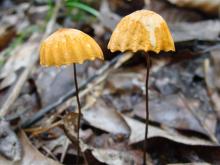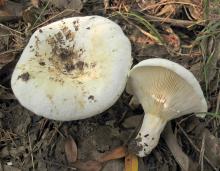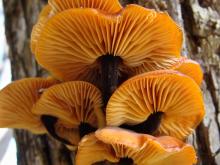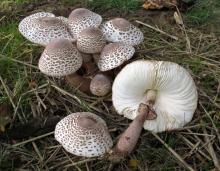Mushrooms
Media

Species Types
Scientific Name
Desarmillaria caespitosa (formerly Armillaria tabescens)
Description
The ringless honey mushroom is honey-colored, with a dry, scaly cap, and lacks a ring on the stalk. It grows in clusters at the bases of trees or stumps, especially of oaks, and over buried wood.
Media

Species Types
Scientific Name
Marasmius siccus
Description
The orange pinwheel marasmius is a tiny mushroom with an orange, bell-shaped, pleated cap, white gills, and a skinny brownish stalk. It grows scattered to many on dead leaves, wood, and twigs of deciduous trees.
Media

Species Types
Scientific Name
Lactarius piperatus
Description
The peppery milky has a white cap with densely crowded gills. It bleeds white and has a spicy-hot taste. It grows scattered in deciduous woods.
Media

Species Types
Scientific Name
Lactarius volemus
Description
The voluminous-latex milky has a velvety, orangish brown cap and stalk, white gills and flesh that exude a milky white latex, and a fishlike odor. It grows scattered in deciduous woods.
Species Types
Scientific Name
Amanita flavoconia
Description
The cap of this mushroom ranges from orange to yellow, with yellowish patches. The stalk has crumbling patches at the base, and a ring. It grows on the ground in mixed woods.
Media

Species Types
Scientific Name
Pleurotus ostreatus and P. pulmonarius
Description
Oyster mushrooms are choice edibles with broad, fleshy, whitish, grayish, or tan caps and a stubby, off-center stalk. They grow clustered on stumps, logs, and trunks.
Media

Species Types
Scientific Name
Phlebia incarnata (formerly Merulius incarnatus)
Description
The coral-pink merulius is a small, semicircular bracket fungus that is pinkish to coral to cream-colored, wrinkled, and veined beneath. It grows on dead logs and stumps of deciduous trees.
Media

Species Types
Scientific Name
Flammulina velutipes
Description
The velvet foot, or enoki, has a tawny, sticky cap with whitish gills. The stalk is yellowish above and brownish below. They grow in clusters on deciduous logs.
Media

Species Types
Scientific Name
Lenzites betulina
Description
Multicolor gill polypore is a bracket fungus with a semicircular, tough, hairy, multicolored, zoned cap; beneath, it's white, with leathery, gill-like tubes. It grows on dead deciduous wood.
Media

Species Types
Scientific Name
Leucoagaricus americanus (Lepiota americana)
Description
The reddening lepiota is a large, reddish brown mushroom with a scaly cap and a ring on the stalk; it bruises dark red. It grows singly or in clusters in mulch piles, waste areas, and around stumps.
See Also



Media

Species Types
Scientific Name
Monotropa hypopitys
Description
Pinesap is a plant that puts the "wild" in wildflower! It lacks chlorophyll, so its roots connect to fungi underground and absorb nutrients from the fungi.
Media

Species Types
Scientific Name
Cladophora, Pithophora, and Spirogyra spp., and others
Description
Filamentous green algae forms green, cottony masses that are free-floating or attached to rocks, debris, or other plants.
Media

Species Types
Scientific Name
Monotropa uniflora
Description
Indian pipe lacks chlorophyll, so it is white, not green. Below ground, its roots join with fungi that connect to tree roots. This plant, then, takes nourishment indirectly from the trees.
About Mushrooms in Missouri
Mushrooms are a lot like plants, but they lack chlorophyll and have to take nutrients from other materials. Mushrooms are neither plants nor animals. They are in a different kingdom — the fungi. Fungi include the familiar mushroom-forming species, plus the yeasts, molds, smuts, and rusts.
Always be cautious when eating edible mushrooms. Be absolutely sure of the ID, and only eat a small amount the first time you try it to avoid a reaction..





















